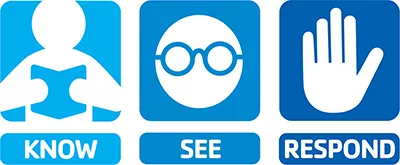


We are passionate about working with kids to develop their potential, while helping them to learn, grow, and thrive.
Locally, with hundreds of children visiting our branches daily, our staff are trained to be alert. It is our responsibility to ensure the kids in our care are happy and free to learn and grow at every turn. And so our YMCA has comprehensive child protection policies and procedures that are reviewed regularly and part of conversations at the Y. Beyond that, it is in the interest of others to know these policies. Together we can be vigilant and look for signs of abuse and neglect.
We as Y staff, members, community members and volunteers need to build on the work we’ve done and develop the three habits in child abuse prevention:
As we see and interact with these three habits and their corresponding images in various ways at our YMCA’s throughout the day, they remind us of our responsibility to safety and what we can do as individuals to protect youth from abuse.
Learn more about how you can protect children
Together, let’s commit to protecting the youth in our YMCA and our communities by practicing the three habits of child abuse protection each day.
Because when we know and understand how abuse happens, see the warning signs, and are prepared to respond quickly to prevent it, we create a culture of child abuse prevention that results in even safer environments for kids to reach their full potential.

KNOW how to recognize boundary violations and how offenders operate. It’s up to us as adults to do all we can to prevent child sexual abuse and create safe environments for children. Teaching children about their bodies, recognizing warning signs, and responding to any concerns are important first steps. Even very young children can learn some skills to help keep themselves safe from sexual abuse, but it’s up to parents to help them learn what they need to know. Here are some important things you can teach that will help you help your child stay safe.
Teach Your Child Rules About Touching Their Body
Preschoolers understand the idea of rules, such as rules about playing nicely with others and rules about being safe, like wearing seat belts. So as you teach these rules, just add rules about touching their bodies.
First, talk to your child about body parts, including private parts. This will give your child words to use when he/she needs to tell you anything about his/her body, like an injury or rash or other problem in that area.
Then add rules about private parts, like “Never let other people touch your private parts unless Mommy or Daddy knows about it.” Children also need to know what to do when someone breaks the rules about touching. Teach them:
SEE. Keep your eyes and ears open for signs of abuse and talk with your child, asking them about your concerns. If something is wrong, you may see a sudden change in your child’s behavior, or you may hear unusual comments. If you see or hear these things, follow up. Find a relaxed time to talk with them.
Child Abuse Warning Signs
Watch for these things in adults that may signify potential abuse. Remember, offenders seek access, privacy & control.
Emotional Boundary Violations
Physical Boundary Violations
Behavioral Boundary Violations
Offenders manipulate kids into doing things they wouldn’t otherwise do, such as:
RESPOND. If you see warning signs from your child or you hear about something that sounds like abuse, report it immediately.
If your child tells you about sexual abuse or inappropriate behavior, your response plays a big role in how your child understands abuse and how he/she recovers.
REPORTING CONCERNS OR RULE VIOLATIONS
Child predators break rules to gain privacy, access, and a relationship with children. People who do not follow child safety rules put all children at risk.
WHAT ARE “RED FLAG BEHAVIORS?
IF YOU OBSERVE RULE BREAKING RED FLAGS OR HAVE ANY CONCERN:
REPORTING SUSPECTED ABUSE
Texas law states anyone who thinks a child, or person 65 years or older, or an adult with disabilities, is being abused, neglected, or exploited, must report it to DFPS. All reports are confidential. These incidents should be handled professionally, confidentially and immediately.